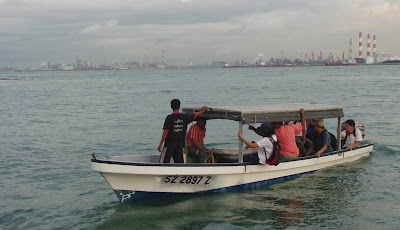Sixty Ninth Discovery Posting:
Along our major shipping lanes, ringed by Jurong Island and Pulau Bukom (where you can find many petrol chemical plants), there lies a haven hidden by the waters, appearing only when the tides are low enough. Can you see it (picture below)?
 As this haven is not connected to any land, the only way to get there is to make an amphibious landing, this calls for a small boat and physically getting wet (part of the fun going for shore trips =P ) (picture below)
As this haven is not connected to any land, the only way to get there is to make an amphibious landing, this calls for a small boat and physically getting wet (part of the fun going for shore trips =P ) (picture below) Why do I call Cyrene Reef a haven?
Why do I call Cyrene Reef a haven?Because studies from Star Trackers show that Cyrene is probably the only reef in Singapore where juvenile Knobblies are commonly seen. And probably also the home to "the only sustainable population of Knobbly sea stars".
Side Note:
a) Star Trackers does monitoring body growth, survivorship, habitat utilization and movement patterns of knobbly seastar (Protoreaster nodosus) individuals at marine habitats in Singapore.
b) And the 'star troopers' running this project is primarily CK and SJ
c) Their blog address is http://startrackers.blogspot.com/
As I explored the reef, I 'discovered' 27 individuals of the Knobbly sea star, below are pictures for some of them. Enjoy~ =)





 This was my favourite star of the day (picture below)
This was my favourite star of the day (picture below)











 You might wonder how big are the juveniles of the knobbly sea star, here's a scale of two with my hand (picture below). Do remember they can grow to as big as your face!
You might wonder how big are the juveniles of the knobbly sea star, here's a scale of two with my hand (picture below). Do remember they can grow to as big as your face! Seeing so many knobbly sea stars really left me star studded. Besides that, knowing a place such as Cyrene Reef exists reminded me once again that our waters although murky, it is rich in marine life! And it will continue to be if we all take care of them one way or another.
Seeing so many knobbly sea stars really left me star studded. Besides that, knowing a place such as Cyrene Reef exists reminded me once again that our waters although murky, it is rich in marine life! And it will continue to be if we all take care of them one way or another.Ways can include:
a) putting your rubbish where they belong (in the rubbish bins or recycle bins), not littering/dumping into our waters,
b) leaving marine life at their homes (don't collect marine life nor shells, cause the empty sea shells may be potential homes for hermit crabs).
c) You can also learn more about them to understand their value in our environment, and probably share this knowledge with your family/friends or possibly even volunteer/blog for our shores!
d) And speak for our shores if possible, because marine life don't speak our language. =)
Very soon, we had to leave Cyrene the way we came (picture below).
 And looking at our busy shipping ports nearby, (with expansion going on nearby Cyrene Reef) (picture below), I marvel at how Cyrene can be so starry. Probably all the strict rules for ships is one factor?
And looking at our busy shipping ports nearby, (with expansion going on nearby Cyrene Reef) (picture below), I marvel at how Cyrene can be so starry. Probably all the strict rules for ships is one factor? Finally, would like to thank Ria for arranging this trip and all who came. =)
Finally, would like to thank Ria for arranging this trip and all who came. =)Extra:
a) Read the entry on wildfilms about this trip to Cyrene.
b) Read more about Cyrene Reef here.
No comments:
Post a Comment